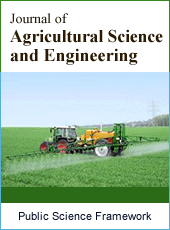Journal of Agricultural Science and Engineering
Articles Information
Journal of Agricultural Science and Engineering, Vol.2, No.1, Feb. 2016, Pub. Date: Feb. 24, 2016
Effect of Concentrate Supplementation on the Performance and Carcass Characteristics of Natural Grazing Sudanese Desert Lambs
Pages: 1-4 Views: 3125 Downloads: 1499
[01]
Asma Himmed Mohammed, Department of Animal Production, Faculty of Agriculture and Environmental Sciences, University of Gadarif, Gadarif, Sudan.
[02]
Yagoub Magboul Yagoub, Department of Animal Production, Faculty of Agricultural Technology and Fish Sciences, Al-Neelain University, Khartoum, Sudan.
This research was carried out to detect the effect of concentrate supplementation on the performance and carcass characteristics of natural grazing Sudanese desert lambs. Twenty one (one year old) male lambs were used for 56 days. These Lambs were divided into three homogenous groups. The three lamb groups grazed on natural pasture for about 8 hours daily. After grazing period the first group (C1) received zero concentrate, the second group (C2) received 200 g/head/day concentrate and the third group (C3) received 400 g/ head/day concentrate. At the end of the feeding trials, the animals were slaughtered for carcass analysis. Final live weights did not differ significantly between treatment groups although lambs fed concentrate level 200g and 400g were heavier than the group that not supplemented concentrate. The daily weight gain was increased with increasing concentrate level. Empty body weight was differed in lambs fed on different levels. Dressing percentage of lambs fed 200g and 400g concentrate were similar and higher than in lambs fed on pasture alone. Weights of the head, blood, feet, lungs, heart, liver, spleen, rumen, gut, mesenteric fat and testicles did not differ, however, weights of skin, tail and kidney differed significantly. The results showed that concentrate supplementation is necessary to improve growth performance.
Concentrate Supplementation, Sudanese Desert Lambs, Carcass Characteristics
[01]
Abdul Elkarim., A. I. and J. B. Owen (1987). Post-weaning performance, carcass characteristics and preliminary heritability estimates for some carcass traits of two types of Sudan Desert Sheep in intensive feeding. J. Agric. Sci. 109: 531 – 538.
[02]
Ali., M. A. M. (2003). Body measurements, performance and meat characteristics of the Desert sheep in the Sudan. Ph.D. (Anim. Science) Thesis, University of Gezira, Sudan.
[03]
Babiker., S. A. and Mohammed, S. A. (1990). Live animals measurements and carcass characteristics of Sudan Desert Sheep and Australian Marino Sheep. The Sudan J. Anim. Prod., 3(1): 9-15.
[04]
Beshir., A. A. (1996). Use of roselle (Hibiscus sabdarifa) seeds for lambs feeding. M.Sc. Thesis, Faculty of Anim. Prod., University of Khartoum.
[05]
Carles., A. B. (1983). Sheep production in the tropics (Oxford University Press. Oxford, U.K) pp 25-43.
[06]
Elhag., G. A. and Mukhtar, A. M. S. (1978). Varying levels of concentrates in the rations of Sudan desert sheep. World Review of Animal Production (Italy).14(4): 73-79.
[07]
El-Khidir., O. A., Badr, A. M. and Murgos, F. I. (1989). Molasses blocks containing oil concentratessupplement in a basal hay diet for feeding Sudan desert lambs. The sudan J. Anim. Prod., 2(2): 79-88.
[08]
Gaili., E. S. E.; Chanen, Y. S. and Mukhtar, A. M. (1972). A comparative study of some carcass characteristics of Sudan Desert sheep and goats. Anim. Prod. 14: 351 – 357.
[09]
Gaili., E. S. E. (1977). Evaluation of body composition of male Sudan Desert Sheep. Trop. Agric. (Trindad), 54(2): 127-133.
[10]
Hagos., T. and S. Melaku (2009). Feed intake, digestibility, body weight and carcass parameters of Afar rams fed tef (Eragrostis tef) straw supplemented with graded levels of concentrate mix. Tropical Animal Health and Production.41 (4): 599-605.
[11]
Kochapakdee, S., Pralomkam, W., Saithanoo, S., Lawpetchara, A. and Norton, B.W. (1994). Grazing management studies with Thai goats:1. Productivity of female goats grazing newly established pasture with varying levels of supplementary feeding.Asian-Aus.J.Anim.Sci.,7:289-293.
[12]
M. L. C. (1976). Meat and livestock commission, England. Cutting and preparing of lamb and pork. Technical Bulletin N. 24: 12-18.
[13]
Mansour., B. M. M. Sulieman, A. H. and Ali, T. E. (1993). The effect of breed and different ratio of groundnut hay, dura on performance and carcass composition of Sudan desert sheep. The Sudan Journal of Anim. Prod.9. p.157.
[14]
Ministry of Animal Resources (2005). General Adminstration for planning and animal resources Economics, Khartoum, Annual Report. Sudan.
[15]
Pomeroy (1952). Live-weight growth in progress in the physiology of farm animals, edited by J. Hammond, Butterworth, London.
[16]
Salim., H. M., Shahjalal, M., Tareque, A. M. M and Kabir, F. (2002). Effects of concentrate supplementation on growth and reproductive performance of female sheep and goats under grazing conditions. Pakistan Journal of Nutrition 1(4):191-193.
[17]
SAS. (1997). Users guide 6th Ed., SAS Inc. Cary N. C.
[18]
Shahjelal., M. D., Gallriath, H. and Topp, J. H. (1992). The effect of changes in dietary protein and energy on growth, body composition and Mohair fibre characteristics of british Angora goats. J. Anim. Prod., 54: 405-412.

ISSN Print: 2381-6821
ISSN Online: 2381-6848
Current Issue:
Vol. 7, Issue 4, December Submit a Manuscript Join Editorial Board Join Reviewer Team
ISSN Online: 2381-6848
Current Issue:
Vol. 7, Issue 4, December Submit a Manuscript Join Editorial Board Join Reviewer Team
| About This Journal |
| All Issues |
| Open Access |
| Indexing |
| Payment Information |
| Author Guidelines |
| Review Process |
| Publication Ethics |
| Editorial Board |
| Peer Reviewers |


